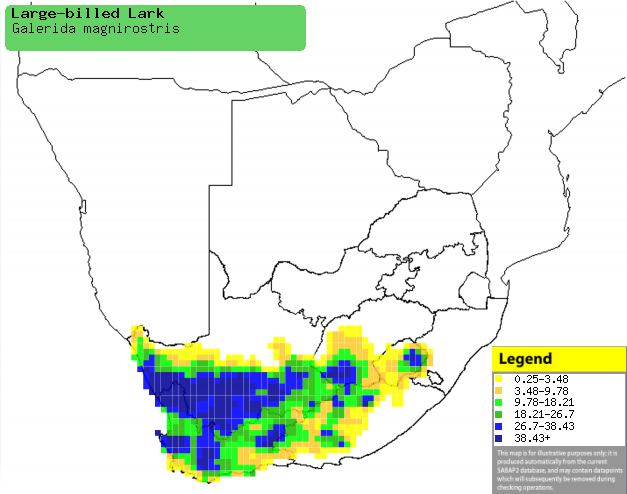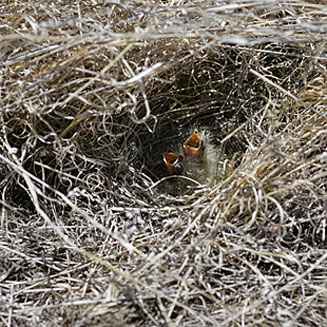|
Galerida magnirostris
(Large-billed lark, Thickbilled lark)
Dikbeklewerik [Afrikaans]; Grootsnavelleeuwerik [Dutch];
Cochevis à gros bec [French]; Dickschnabellerche [German];
Cotovia-de-bico-grosso [Portuguese]
Life
> Eukaryotes >
Opisthokonta
> Metazoa (animals) >
Bilateria >
Deuterostomia > Chordata >
Craniata > Vertebrata (vertebrates) > Gnathostomata (jawed
vertebrates) > Teleostomi (teleost fish) > Osteichthyes (bony fish) > Class:
Sarcopterygii (lobe-finned
fish) > Stegocephalia (terrestrial
vertebrates) > Tetrapoda
(four-legged vertebrates) > Reptiliomorpha > Amniota >
Reptilia (reptiles) >
Romeriida > Diapsida > Archosauromorpha > Archosauria >
Dinosauria
(dinosaurs) > Saurischia > Theropoda (bipedal predatory dinosaurs) >
Coelurosauria > Maniraptora > Aves
(birds) > Order: Passeriformes
> Family: Alaudidae
Distribution and habitat
Near-endemic to southern Africa, occurring from the extreme
south of Namibia to the Northern, Western and Eastern Cape, as well as Lesotho,
the Free State and KwaZulu-Natal. In the Western Cape it is most common in
succulent Karoo and cultivated land, also occupying coastal fynbos, high
altitude grassland and shrub-lined rivers and streams.
|
 |
|
Distribution of Large-billed lark in southern Africa,
based on statistical smoothing of the records from first SA Bird Atlas
Project (©
Animal Demography unit, University of
Cape Town; smoothing by Birgit Erni and Francesca Little). Colours range
from dark blue (most common) through to yellow (least common).
See here for the latest distribution
from the SABAP2. |
Food
It mainly eats insects and seeds supplemented with fruit,
doing most of its foraging on the ground, pecking food items from soil and the
bases of plants and occasionally digging for bulbs and seeds with its large
bill. The following food items have been recorded in its diet
- Insects
- ants (e.g. Monomorium)
- Blattidae (roaches)
- Coleoptera
(beetles and their larvae)
-
caterpillars (larval stage of
Lepidoptera)
-
termites
- Hodotermes mossambicus (Northern harvester termite)
- Microhodotermes viator (Southern harvester termite)
-
Orthoptera (grasshoppers)
- Seeds
- sedges
- grasses
- cereals
- legumes
- forbs and succulents
- Arctotis
- Polygonum
- Hermannia
- Tetragonia echinata
- Malephora lutea
- Aridaria
- Aizoon
Breeding
- The nest (see image below) is an open cup built of twigs, coarse grass and
rootlets, often lined with finer material such as wool, feathers and plant
down. It is typically placed on a foundation of twigs in an excavated
burrow, usually at the base of a shrub, grass tuft or stone, occasionally
out in the open.
 |
|
|
Large-billed lark nest with chicks, Springfontein,
South Africa. [photo Warwick Tarboton ©] |
|
- Egg-laying season is from July-December, usually peaking earlier in the
winter rainfall area.
- It lays 2-4 eggs, which are incubated for roughly 16 days.
- The chicks are brooded for the first 5 days of their lives by both
parents, both of whom also take care of the feeding. They are are
particularly fearless when defending the nest from intruders, either
performing a distraction display or even flying straight into the face of a
person!
Threats
Not threatened, in fact it has benefited greatly from the
introduction of agriculture in the Western Cape.
References
-
Hockey PAR, Dean WRJ and Ryan PG 2005. Roberts
- Birds of southern Africa, VIIth ed. The Trustees of the John Voelcker
Bird Book Fund, Cape Town.
|
